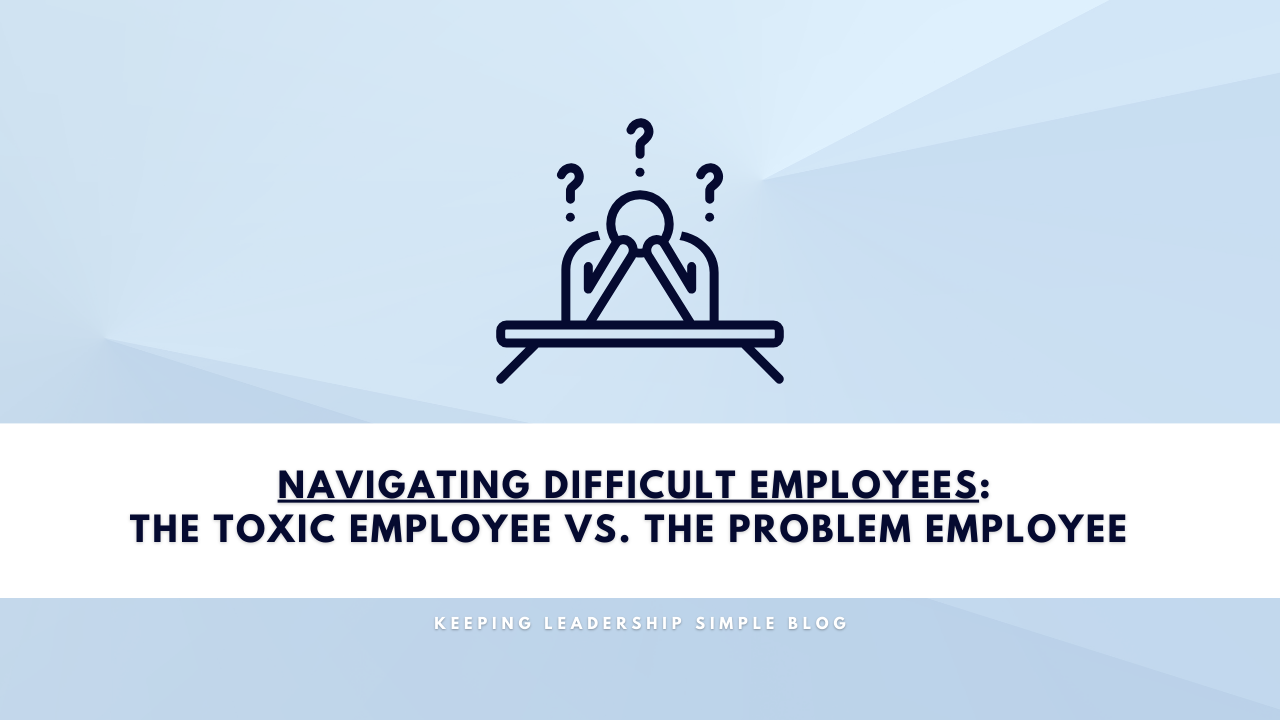Navigating Difficult Employees: The Toxic Employee vs. The Problem Employee
Feb 26, 2025
Leadership is about managing people, and sometimes, that means dealing with employees who create challenges within the organization. Not all problem employees are the same, though. Some are high performers who excel at their work but poison the workplace culture with their attitude and need for recognition. Others are simply disengaged and unmotivated, constantly pushing back against policies and standards. Both types require different leadership approaches.
Let's break down these two types of difficult employees, their impact on the organization, and how to handle them effectively.
The Toxic Employee
A toxic employee is a high performer who delivers excellent results but creates division within the team. They thrive on recognition and attention, often taking credit for successes while placing blame elsewhere for failures. Their technical skills or productivity may be undeniable, but their interpersonal skills are lacking, making it difficult for them to work effectively with others.
Signs of a Toxic Employee:
✔️ Delivers strong results but resents teamwork
✔️ Seeks credit and recognition at every opportunity
✔️ Undermines colleagues or leadership
✔️ Creates drama and conflict within the organization
✔️ Resists feedback and believes they are indispensable
Impact on the Organization:
While their work may be top-notch, the collateral damage they cause—low morale, team dysfunction, and unnecessary drama—can outweigh their contributions. A toxic employee often discourages teamwork and creates a culture where others feel unvalued or hesitant to collaborate. If left unchecked, they can drive away good employees who don't want to deal with their behavior.
How to Manage a Toxic Employee:
1. Address the Behavior Directly – Do not ignore the issue just because they produce results. Have a one-on-one conversation emphasizing that teamwork and attitude matter as much as performance.
2. Set Clear Expectations – Make it clear that individual success should never come at the expense of the team. Reinforce a culture of shared accomplishments.
3. Limit Their Influence– Reduce their ability to disrupt the team by ensuring credit is evenly distributed and that they are not given excessive authority without accountability.
4. Consider Whether They Are Worth Keeping– If their toxicity is eroding the organization's culture, you may have to make a tough decision. No employee is too valuable to be held accountable.
The Problem Employee
Unlike the toxic employee, the problem employee does not deliver high-quality work. They are disengaged, resist policies, and put in minimal effort. This employee may have a history of disciplinary issues, frequent conflicts with leadership, and a general lack of motivation.
Signs of a Problem Employee:
❌ Struggles with meeting standards or expectations
❌ Pushes back against policies and procedures
❌ Demonstrates a lack of motivation and effort
❌ Frequently has performance or disciplinary issues
❌ Avoids accountability and makes excuses
Impact on the Organization:
Problem employees create an atmosphere of mediocrity. When leadership tolerates low effort and non-compliance, it sends the message that standards don't matter. This can lead to decreased productivity and resentment among hardworking employees who have to pick up the slack.
How to Manage a Problem Employee:
1. Identify the Root Cause – Is the issue a lack of training, personal challenges, or just laziness? Understanding the "why" behind their behavior helps determine the next steps.
2. Set Clear Performance Goals – Establish measurable benchmarks with deadlines to track progress. Provide regular feedback.
3. Use Progressive Discipline – If they refuse to improve, follow a structured disciplinary process that outlines consequences for continued underperformance.
4. Hold Them Accountable – Enforce standards consistently. If improvement doesn't happen, be prepared to take appropriate action, up to and including termination.
Final Thoughts: Choosing the Right Leadership Approach
Both types of employees pose challenges, but they require different strategies. A toxic employee needs to be reminded that teamwork and culture matter just as much as individual achievements. A problem employee needs to be given clear expectations and held accountable for their effort and attitude.
Strong leadership means not tolerating either extreme—allowing toxicity to fester or letting mediocrity take root. The key is addressing the issue head-on with firm, fair, and consistent leadership.
At the end of the day, no single employee should be allowed to compromise the success of the organization. As leaders, it's our job to protect both performance and culture—because both are essential to long-term success.
What are your experiences in dealing with these types of employees? Share your thoughts in the comments!
- Dean
Stay connected with news and updates!
Join our email list to receive the latest news and updates from the LHLN team!
We will never sell your information, for any reason.
